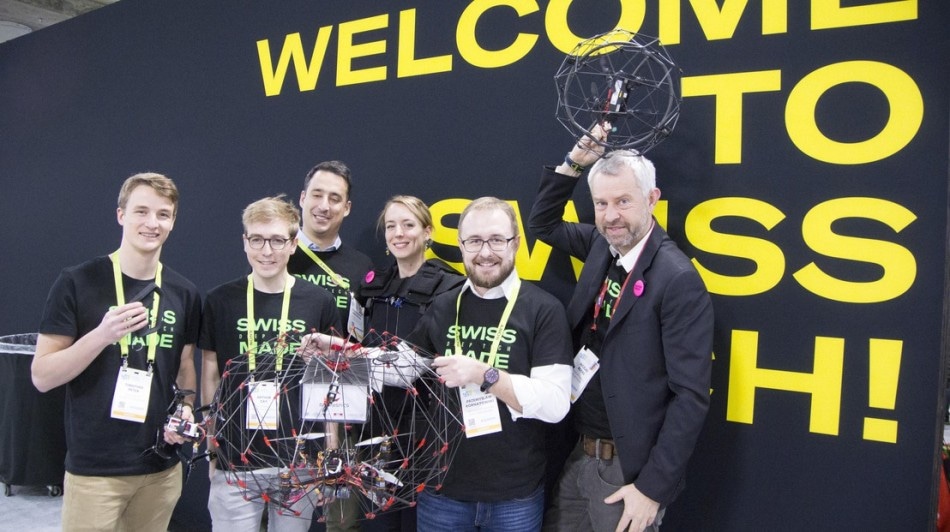Jan 11 2019
Four innovative drones, designed by EPFL, are being demonstrated in the Swiss Pavilion at the Consumer Electronics Show (CES) being held in Las Vegas.
 (Image credit: EPFL)
(Image credit: EPFL)
Attempting to follow in the paths of Pix4D and Flyability, the spin-offs developing the drones are establishing themselves in the global market. More than Switzerland’s “Drone Valley,” Swiss chocolate may be more familiar to Americans. However, specialists in the United States are keeping a close watch on the technologies being created in this country.
This week, a humming noise can be heard at CES in Las Vegas every couple of hours—that is when the drones emerge at the Swiss Pavilion. While the noise may intrigue some onlookers, others have particularly come to watch the demonstrations that take place for 15 minutes, which are introduced by the head of Presence Switzerland, Nicolas Bideau. However, the 200 m² area spread around the stand is not sufficiently large to house all the spectators, some of whom try to catch a glimpse of the action, standing on their tiptoes in the aisles. In every demonstration and the subsequent follow-up Q&A session, it is evident that these aircraft—the majority of which were created at EPFL—are attracting a great deal of interest from professionals searching for potential investment opportunities or partnerships.
As far as US specialists are concerned, Switzerland—with its “Drone Valley”—is not essentially a country they identify with aerial technology. Yet, as Romeo Durscher, the director of Public Safety Integration at multinational drone specialist DJI, says, “The real experts know what’s happening, and they like the positive, professional and visionary approach emerging in Switzerland, in particular around its elite universities.”
In fact, a few Swiss startups have been successful in the US, like Pix4D and Flyability—two EPFL spin-offs that have established robust positions in the U.S. market. The mapping and measurement software from Pix4D is extensively used by industry professionals, while Flyability’s drones, in their protective frames, are capable of bouncing off obstacles and continuing on their way.
Intuitive piloting
To date, EPFL has spun off about 12 drone-related startups, but several other aerial technologies are also under development in its laboratories. If these technologies can be turned into viable solutions, they can perhaps be converted into business ventures in the future—an excellent example of this is Flyjacket, which emerged from the Laboratory of Intelligent Systems of EPFL.
Events like CES not only raise our profile but also allow us to bounce our technology off a large number of specialists, so that we can position ourselves more effectively in the market.
Carine Rognon, Flyjacket.
Arthur Gay and Timothée Peter established the startup MotionPilot much before they had completed their studies. The duo is visiting the stands of prospective partners at CES and demonstrating their joystick, which makes it more intuitive to pilot a drone.
“For the 60 years that drones have existed, the market has been dominated by conventional remote controls,” stated DJI’s Durscher, a Swiss native who has been living in the United States for two decades. “The new applications we are seeing, along with the foldable, haptic-feedback joystick that could work with drones, are in keeping with the market trend towards more intuitive ways to fly drones, particularly for rescue missions.”
Durscher is also excited about Dronistics, which is designing drones flying within a light, foldable cage. These drones could provide a standard solution for conventional, short-distance parcel deliveries, similar to how emails have replaced letters.
Getting to the starting blocks at the right time
By visiting CES—through the help of Switzerland Global Enterprise and Presence Switzerland Enterprise—and participating in other programs established by both private- and public-sector organizations, Swiss startups can start meeting people and learn a lot about the US market. However, this second phase has to take place very quickly because speed is highly significant in the United States, even more than in Switzerland.
However, according to Durscher, the race should not begin too early in an organization’s life cycle: “It’s better to take full advantage of all available financial assistance and build a solid project before going to market. It’s not easy to convince investors, including in Silicon Valley, and it’s best to arrive with a well-developed technology and a clear message.”
The race starts once a company hits the starting blocks. For Christian Simm, who worked as CEO of Swissnex San Francisco for 10 years and is currently the CEO of Swissnex Boston, companies should never be scared to knock on opportunities and should get back in touch with the contacts they have established. “After a meeting, it’s almost standard practice in the US—and particularly in Silicon Valley—to get a follow-up email before you’ve even made it back to the office,” he says with a smile.
The element of surprise
Finally, the fact that the United States does not consider Switzerland as a top player in drone technology—at least, not yet—can at times prove to be an advantage. The element of surprise can make a major difference, stated Simm, who usually hears comments like: “Why didn’t we know that you had this level of technology in Switzerland?” Perhaps, Switzerland may become more famous for its drones than for its watches and chocolate in the future.
Les drones de l'EPFL au CES Las Vegas
(Video credit: EPFL)